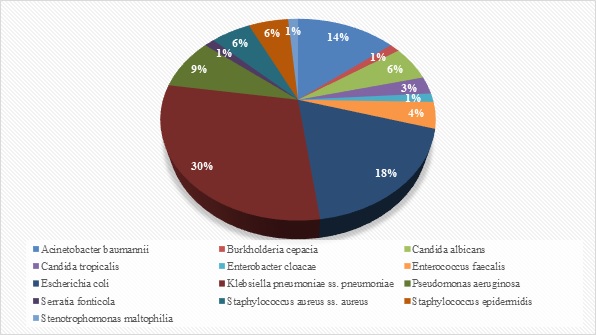Incidence, microbiological profile and outcome of ventilator-associated events in a tertiary care hospital in Bangalore, Karnataka, India
Abstract
Introduction: Despite different ICU admission causes, ventilator-associated event (VAE) is still a common cause of mortality and morbidity in intubated patients and impedes obvious progression in diagnostic modalities and management of these infections.
Objectives: The aim of this study was to estimate VAE incidence, detection of antimicrobial resistance pattern’s which can help in the management and to follow the outcome of the patients having VAE.
Materials and methods: This was a retrospective study done over a period of 24months from January 2018 to December 2019 in a tertiary care hospital in Bangalore. The study population included all the confirmed VAE patients. Their incidence of microbiological profile and the outcome was noted.
Results: Out of 422 mechanical ventilated (MV) patients 71 patients developed VAE. In the 71 proved VAE cases 48 (67.6%) were male and23 (32.4%) were females. Out of 71 cases, the mean age who were having VAE falls in the range of 65- 75 yrs. The incidence of VAE is 16.82 and the incidence density:9.78 /1000 ventilator days. Klebsiella pneumonia (29.5%) was the common organism isolated among 71 cases.
Conclusion: Utilizing the preventive, diagnostic, and treatment recommendations outlined should allow for improved outcomes for a common and serious medical complication seen in ICU mechanically ventilated patients.
Downloads
References
Lima J, Alves LR, Paz J, Rabelo MA, Maciel MAV, Morais MMC. Analysis of biofilm production by clinical isolates of Pseudomonas aeruginosa from patients with ventilator-associated pneumonia. Rev Bras Ter Intensiva. 2017;29(3):310-316. doi: https://dx.doi.org/10.5935%2F0103-507X.20170039.
Fialkow L, Farenzena M, Wawrzeniak IC, Brauner JS, Vieira SR, Vigo A, et al. Mechanical ventilation in patients in the intensive care unit of a general university hospital in southern Brazil: an epidemiological study. Clinics. 2016;71(3):144-151. doi: https://dx.doi.org/10.6061%2Fclinics%2F2016(03)05.
Slutsky AS. History of mechanical ventilation. from vesalius to ventilator induced lung injury. Am J Respir Crit Care Med. 2015;191(10):1106-1115. doi: https://doi.org/10.1164/rccm.201503-0421PP.
Vincent JL, Akca S, De Mendonca A, Haji-Michael P, Sprung C, Moreno R, et al. The epidemiology of acute respiratory failure in critically ill patients (*). Chest. 2002;121(5):1602-1609. doi: https://doi.org/10.1378/chest.121.5.1602.
American Thoracic S, Infectious Diseases Society of A. Guidelines for the management of adults with hospital-acquired, ventilator-associated, and healthcare-associated pneumonia. Am J Respir Crit Care Med. 2005; 171(4):388-416. doi: https://doi.org/10.1164/rccm.200405-644ST
Torres A, Ferrer M, Badia JR. Treatment guidelines and outcomes of hospital-acquired and ventilator-associated pneumonia. Clin Infect Dis. 2010;51(9):S48-S53. doi: https://doi.org/10.1086/653049.
Joseph NM, Sistla S, Dutta TK, Badhe AS, Parija SC. Ventilator associated pneumonia in a tertiary care hospital in India: incidence and risk factors. J Infect Dev Ctries. 2009;3(10):771-777. doi: https://doi.org/10.3855/jidc.396.
Klompas M. Does this patient have ventilator-associated pneumonia? J Am Med Assoc. 2007;297(14):1583-1593. doi: https://doi.org/10.1001/jama.297.14.1583.
Fabregas N, Ewig S, Torres A et al. Clinical diagnosis of ventilator associated pneumonia revisited: comparative validation using immediate post-mortem lung biopsies. Thorax. 1999;54(10):867-873. doi: https://doi.org/10.1136/thx.54.10.867.
Stewart NI, Cuthbertson BH. The problems diagnosing ventilator associated pneumonia. J Intensive Care Soc. 2009;10(4):267-272.
Pugin J, Auckentaler R, Mili N et al. Diagnosis of ventilator-associated pneumonia by bacteriologic analysis of bronchoscopic and nonbronchoscopic ‘blind’ bronchalveolar lavage fluid. Am Rev Respir Dis. 1991;143(5):1121-1129. doi: https://doi.org/10.1164/ajrccm/143.5_Pt_1.1121.
Horan T, Andrus M, Dudeck M. CDC/NHSN surveillance definition of health care-associated infection and criteria for specific types of infections in the acute care setting. Am J Infect Control. 2008;36(9):309-332. doi: https://doi.org/10.1016/j.ajic.2008.03.002.
Morris AC, Hay AW, Swann DG, Everingham K, McCulloch C, McNulty J, et al. Reducing ventilator-associated pneumonia in intensive care: impact of implementing a care bundle. Crit Care Med.2011;39(10):2218-2224. doi: https://doi.org/10.1097/CCM.0b013e3182227d52.
Rello J, Alfonso E, Lisboa T, Ricart M, Balsera B, Rovira A, et al. A care bundle approach for prevention of ventilator-associated pneumonia. Clin Microbiol Infect. 2013;19(4):363-369. doi: https://doi.org/10.1111/j.1469-0691.2012.03808.x.
Zilberberg MD, Shorr AF, Kollef MH. Implementing quality improvements in the intensive care unit: ventilator bundle as an example. Crit Care Med. 2009;37(1):305-309. doi: https://doi.org/10.1097/CCM.0b013e3181926623.
Nseir S, Zerimech F, Fournier C, Lubret R, Ramon P, Durocher A, et al. Continuous control of tracheal cuff pressure and microaspiration of gastric contents in critically ill patients. Am J Respir Crit Care Med. 2011;184(9):1041-1047. doi: https://doi.org/10.1164/rccm.201104-0630OC.
Muscedere J, Rewa O, McKechnie K, Jiang X, Laporta D, Heyland DK. Subglottic secretion drainage for the prevention of ventilator-associated pneumonia: a systematic review and meta-analysis. Crit Care Med. 2011;39(8):1985-1991. doi: https://doi.org/10.1097/CCM.0b013e318218a4d9.
Coppadoro A, Bittner E, Berra L. Novel preventive strategies for ventilator-associated pneumonia. Crit Care. 2012;16(2):210. doi: https://dx.doi.org/10.1186%2Fcc11225.
Kollef MH, Afessa B, Anzueto A, Veremakis C, Kerr KM, Margolis BD et al. Silver-coated endotracheal tubes and incidence of ventilator-associated pneumonia: the NASCENT randomized trial. J Am Med Assoc. 2008;300(7):805-813. doi: https://doi.org/10.1001/jama.300.7.805.
Adair CG, Gorman SP, Byers LM et al. Eradication of endotracheal tube biofilm by nebulised gentamicin. Intensive Care Med. 2002;28:426-431. doi: https://doi.org/10.1007/s00134-002-1223-8.
Delaney A, Gray H, Laupland KB, Zuege DJ. Kinetic bed therapy to prevent nosocomial pneumonia in mechanically ventilated patients: a systematic review and meta-analysis. Crit Care. 2006;10(3):R70. doi: https://doi.org/10.1186/cc4912.
Liu K, Zhu Y, Zhang J et al. Probiotics’ effects on the incidence of nosocomial pneumonia in critically ill patients: a systematic review and meta-analysis. Crit Care. 2012;16(3):R109. doi: https://doi.org/10.1186/cc11398.
Ahmed NH, Hussain T, Biswal I. Antimicrobial resistance of bacterial isolates from respiratory secretions of ventilated patients in a multispecialty hospital. Avicenna J Med. 2015;5(3):74-78. doi: https://doi.org/10.4103/2231-0770.160233.
Song X, Chen Y, Li X. Differences in incidence and outcome of ventilator associated pneumonia in surgical and medical ICUs in a tertiary hospital in China. Clin Respir J. 2014;8(3):262–268. doi: https://doi.org/10.1111/crj.12036.
Sharpe JP, Magnotti LJ, Weinberg JA, Brocker JA, Schroeppel TJ, Zarzaur BL, et al. Gender disparity in ventilator-associated pneumonia following trauma: identifying risk factors for mortality. J Trauma Acute Care Surg. 2014;77(1):161-165. doi: https://doi.org/10.1097/TA.0000000000000251.
Goel V, Hogade SA, Karadesai S. Ventilator associated pneumonia in a medical intensive care unit: microbial aetiology, susceptibility patterns of isolated microorganisms and outcome. Indian J Anaesth. 2012;56(6):558-562. doi: https://doi.org/10.4103/0019-5049.104575.

Copyright (c) 2020 Author (s). Published by Siddharth Health Research and Social Welfare Society

This work is licensed under a Creative Commons Attribution 4.0 International License.


 OAI - Open Archives Initiative
OAI - Open Archives Initiative


